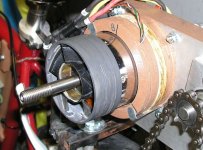So, it's been hypothesized that the open-design of an outrunner helps the motor cool itself, and that by spinning the motor, the spinning helps circulate the air and cool it off even faster.
So, this is the motor I'm using (Unlike what's pictured, it also has a skirt bearing and the can has screws in it; it's also colored orangish instead of blue.):
http://www.hobbycity.com/hobbycity/store/uh_viewItem.asp?idProduct=4188
And the voltage I was using was 29 volts.
I spun the motor at no-load which, during testing, consumes somewhere around 4 Amps.
That implies the motor was spinning 29*230 kV = 6670 RPM or thereabouts.
With the courtesy of an extra 200 pounds of load provided by a relative on a bicycle and towing him up a hill, I was easily able to get the motor's winding upto 185 degrees fahrenheit. After detaching the drive system and spinning the motor at no-load for a minute, it decreased to 175 degrees. After doing it for another minute, it decreased to 165 degrees.
Now, for the comparison testing. I measured the motor's winding's temperature, just let it sit, and then measured it again sometime later. Doing this, I recorded 180 degrees when I first began and then recorded 148 degrees 7 minutes later.
This implies the average cooling rate while at rest is (180-148)/7 = 4.57 degrees fahrenheit per minute.
At 6600 RPM, the average cooling rate was 10 degrees fahrenheit per minute.
So it appears that spinning does enhance cooling, though only upto 10 degrees fahrenheit per minute in my testing.
For my application, I kind of wished it was faster because, if the motor is at the "danger zone" of 250 degrees or so, then that implies I might have to wait 8ish minutes to get the motor down to 130-140 degrees using active cooling, or 15ish minutes using natural cooling at rest. While faster, 8 minutes is kind of a long time.
So, this is the motor I'm using (Unlike what's pictured, it also has a skirt bearing and the can has screws in it; it's also colored orangish instead of blue.):
http://www.hobbycity.com/hobbycity/store/uh_viewItem.asp?idProduct=4188
And the voltage I was using was 29 volts.
I spun the motor at no-load which, during testing, consumes somewhere around 4 Amps.
That implies the motor was spinning 29*230 kV = 6670 RPM or thereabouts.
With the courtesy of an extra 200 pounds of load provided by a relative on a bicycle and towing him up a hill, I was easily able to get the motor's winding upto 185 degrees fahrenheit. After detaching the drive system and spinning the motor at no-load for a minute, it decreased to 175 degrees. After doing it for another minute, it decreased to 165 degrees.
Now, for the comparison testing. I measured the motor's winding's temperature, just let it sit, and then measured it again sometime later. Doing this, I recorded 180 degrees when I first began and then recorded 148 degrees 7 minutes later.
This implies the average cooling rate while at rest is (180-148)/7 = 4.57 degrees fahrenheit per minute.
At 6600 RPM, the average cooling rate was 10 degrees fahrenheit per minute.
So it appears that spinning does enhance cooling, though only upto 10 degrees fahrenheit per minute in my testing.
For my application, I kind of wished it was faster because, if the motor is at the "danger zone" of 250 degrees or so, then that implies I might have to wait 8ish minutes to get the motor down to 130-140 degrees using active cooling, or 15ish minutes using natural cooling at rest. While faster, 8 minutes is kind of a long time.



